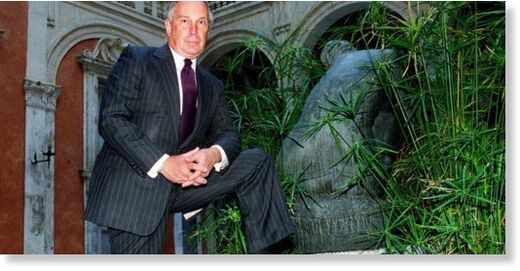The main culprit in this amazing tale will not be unknown to regular readers of the Daily Sceptic and it is the improbable scenario of RCP8.5. This has been promoted as a 'business as usual' set of scientific, economic and societal assumptions and it suggests temperature rises up to 4°C in less than 80 years. Although downgraded by the UN's Intergovernmental Panel on Climate Change of late as "low likelihood", it is still estimated to be behind about 50% of the climate modelled 'impacts' highlighted over the entire scientific literature. Almost all the claims of climate Armageddon and economic disaster peddled by those identified in our first paragraph are based on RCP8.5 input. It is a tale of how three wealthy men bankrolled a project to promote an extreme scenario to guarantee that the economic impact of climate change they projected into the future would be "eye-poppingly large".
It will also not be a surprise to learn that the billionaire green activist Michael Bloomberg has played a key role over the last decade in lifting this implausible pathway to underserved prominence. Notes Pielke:
"It's a story of privilege and conceit - the privilege in American democracy that accompanies being mindbogglingly wealthy, and the conceit that climate policies can best be pursued by corrupting the scientific literature on climate change."In 2012, three wealthy men, Bloomberg, hedge fund manager Tom Steyer and former CEO of Goldman Sachs Hank Paulson chipped in $500,000 each to fund a project "making the climate threat feel real, immediate and potentially devastating to the business world". An early funded report was part-titled 'Risky Business' and it focused on RCP8.5 "as the pathway closest to a business-as-usual trajectory". The pathway was said to be "closest to a future without concerted action to reduce future warming".
In Pielke's view, the authors of the 'Risky Business' report made two significant methodological mistakes. They characterised the extreme RCP8.5 scenario as 'business as usual' and suggested the world could move from one scenario to another. As Pielke notes, the four different scenarios are independent with, for instance, RCP2.5 assuming a world with three billion people fewer than RCP8.5. Both of the mistaken methodological choices were said to be contrary to the appropriate use set by the people who created them.
The "genius" of 'Risky Business' was it undertook a "sophisticated campaign" to introduce its methodological ideas into mainstream scientific literature, "where they would take on a life of their own". In 2016, a paper from the 'Risky Business' project was published in the prestigious journal Science featuring the erroneous notion of moving from one RCP scenario to another. Despite the obvious methodological flaw, notes Pielke, the paper passed peer-review with little or no criticism, and to date has been cited more than 1,100 times. "Hundreds, maybe thousands of papers followed similarly in adopting the same assumption of moving between incommensurate scenarios", observes Pielke.
A year later, Science published another study from 'Risky Business' with the bizarre suggestion that the United States would see a 10% hit to its economy under the most extreme version of RCP8.5, with an incredible 8°C rise in temperature by the end of the century. This prominent paper has been cited more than 1,100 times in other studies and, noted Piekle, the 10% GDP loss would become the top line conclusion of the U.S. National Climate Assessment the very next year.
"Publishing papers in the academic literature based on the flawed 'Risky Business' methods was a formula that would be repeated time and time again. Like the introduction of a virus, the misleading reinterpretation of climate scenarios expanded throughout climate science," states Pielke.
The work begun by Bloomberg-Steyer-Paulson was subsequently taken up by a group called Climate Impact Lab, a collaboration of 'Risky Business' leaders and several universities. According to Pielke, Climate Impact Lab has thrived on using RCP8.5 to generate a steady series of media-friendly studies projecting extreme climate impacts. Among them are stories suggesting rising sea levels could swamp major cities and displace almost 200 million people, while a rise in climate related deaths will surpass all infectious disease. All backed, of course, by 'scientists say'.
Pielke concludes that there is no hidden conspiracy - "all of this is taking place in plain sight". The political advocacy was "absolute genius" - a well-funded effort to fundamentally change how climate science was reported in the media, and ultimately how political discussion and policy options are shaped.
"This effort has been phenomenally successful," says Pielke - or as we might put it, complete Dale-ification of most climate and Net Zero debate has been achieved.




Reader Comments
Whitney focuses on the Digiital ID as being supported by every nation is accurate. Furthermore, the "sustainable" goals of agend 2030 and the new monetization of "carbon" are also on the table. Whitney indicates that the Southern border wall is to be replaced with a "smart" system that tracks people with their DIgital ID. Certainly, the AI is being pushed in chatGPT and in its control over IDF's attacks on Gaza.